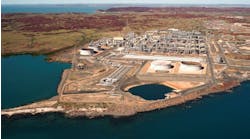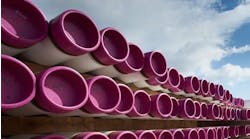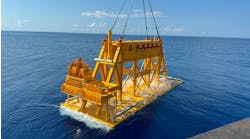Eldon BallSenior Editor Technology & Economics
The Pazflor field offshore Angola boasts a number of firsts. Foremost among them is that it is the first-ever project anywhere to deploy a development plan based on gas/liquid separation at the mudline spanning several reservoirs.
ThePazflor FPSO is the largest in the world at 325 m (1,066 ft) long, 62 m (203 ft) wide and a weight of more than 120,000 metric tons.
This technological innovation is what will make it possible to produce the heavy, viscous oil contained in three of the four reservoirs in this gigantic development in the Angolan deep offshore.
Pazflor, operated by French oil company Total, lies 150 km (93 mi) off Luanda in water depths ranging from 600 to 1,200 m (1,968-3,937 ft) and has estimated proved and probable reserves of 590 MMbbl. The field will gradually ramp up to its full production capacity of 220,000 b/d over the coming months.
"Pazflor's start-up, several weeks ahead of schedule and within budget, is a remarkable achievement of the teams involved," said Yves-Louis Darricarrère, president of exploration and production at Total. "The support and trust of Sonangol, our concession holder and partner, also made an invaluable contribution to our efficiency."
Pazflor comprises a vast subsea gathering network, the most complex ever built in Angola, including 180 km (111.8 mi) of lines tying in 49 subsea wells and 10,000 metric tons of subsea equipment and the giant Pazflor FPSO.
Held in position by 16 subsea mooring connectors, the FPSO is the largest in the world at 325 m (1,066 ft) long, 62 m (203 ft) wide and a weight of more than 120,000 metric tons. It can store up to 1.9 MMbbl of oil that is then exported to tankers via an offloading buoy. The associated gas is re-injected into the reservoir, but could also be exported to the Angola LNG plant once the latter becomes operational.
ThePazflor FPSO was constructed in South Korea by Daewoo Shipbuilding and Marine Engineering (DSME), which was contracted to provide the engineering, procurement, and construction for the FPSO vessel's moorings, hull, and topsides. In turn, Daewoo awarded KBR the contract to provide topsides engineering, procurement, and interface design services for the FPSO.
The FPSO has a topside weight of 35,494 metric tons. It is designed with a processing capacity of 200,000 b/d of oil and 150 MMcf/d of gas. Facilities are planned for a 20-year design life, and quarters are provided for 220 operation and maintenance personnel. It began the 10,000-nautical-mile (19,000 km; 12,000 mi) journey to Angola in January, towed by three Fairmount Marine tugs, and was moored and installed on arrival.
A key technical challenge was producing two very different grades of oil from four separate reservoirs. Producing the heavy, viscous oil from the three Miocene reservoirs, which account for two-thirds of the reserves, and the related flow assurance constraints, represented a major challenge. The gas has to be separated from the liquids on the seabed so that the viscous liquids can then be pumped to the surface. The design and installation of subsea gas/liquid separation units and pumps are a world first on this scale. The pumps were purpose designed and tested for Pazflor.
Pazflor's first discovery – the Perpetua reservoir – came in 2000. Acacia and Zinia were discovered in 2002, followed by Hortensia in 2003. Pazflor encompasses all four reservoirs and covers an area of over 600 sq km (231 sq mi).
Acacia contains light, good quality oil, similar to that of Girassol. The Perpetua, Zinia, and Hortensia reservoirs contain heavier, more viscous oil, making them more difficult to produce. Total decided to combine the production of these two very different oils, in keeping with its ongoing aim of optimizing the production of deep offshore resources. The choice called for two different subsea production systems tied into a single FPSO.
For the three Miocene reservoirs containing heavy oil, the gas is separated from the oil and water on the seabed. Once separated, the oil and water are forced to the surface using pumps designed for Pazflor, also installed on the seabed. The lighter gas rises naturally to the FPSO. The subsea modules are critical to production and are designed to operate for a 20-year period.
FMC Technologies supplied the three subsea separation systems. FMC Technologies also supplied the field's 49 subsea trees (25 production, 22 water-injection and two gas-injection trees) and 49 wellhead systems. In addition, the company provided three four-slot production manifold systems, a production control and umbilical distribution system, gas export and flowline connection systems, ROV tooling, and local support for installation and start-up activities.
Total awarded a $1.1-billion contract for subsea work to a consortium led by Technip and including Acergy. Technip was responsible for engineering, procurement, fabrication, and installation of more than 80 km (50 mi) of production and water injection rigid flowlines, flexible risers, and integrated production bundle risers, plus engineering, procurement, and fabrication of 60 km (37 mi) of umbilicals. Installation was by Technip's vesselsDeep Blue and Deep Pioneer.
Acergy was responsible for engineering, procurement, fabrication, and installation of 55 km (34 mi) of water injection, gas injection, and gas export lines, umbilicals, and 20 rigid jumpers.
Pazflor by the numbers
- 150 km (93 mi) offshore, comprises four reservoirs covering 600 sq km (231 sq mi)
- 600 to 1,200 m water depth
- FPSO is 325 m (1,066 ft) long, 62 m (203 ft) wide
- Living quarters for 140 people
- Production plateau of 220,000 b/d
- Two subsea production systems encompass 49 wells (25 producers, 22 water injectors and two gas injectors) and three subsea separation units connected to six pumps
- 180 km (111.8 mi) of pipeline
- 60 km (37 mi) of umbilicals
Offshore Articles Archives
View Oil and Gas Articles on PennEnergy.com




